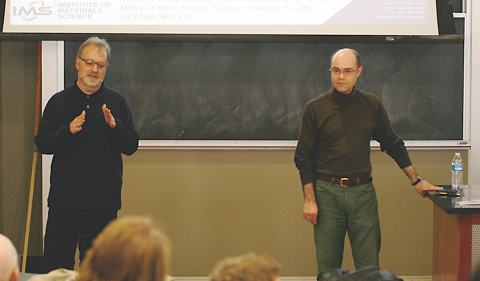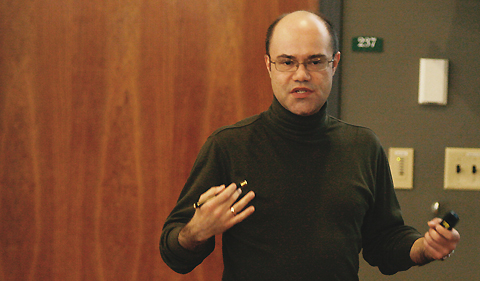By Jean Andrews
Physics & Astronomy
Ohio University alum and condensed matter physicist Serge Nakhmanson ’01PhD, a self-described “digital alchemist,” returned recently to his alma mater as a guest colloquium speaker.
In addition to presenting on “Computational Design of Multifunctional Complex-oxide Materials Across Length Scales” last March, he talked about his first day at Ohio University and his life journey—from Russia to a physics doctoral student at Ohio University to his most recent appointment as Associate Professor in Materials Science & Engineering at the University of Connecticut.
His OHIO adviser, Dr. David Drabold, a Distinguished Professor in the Department of Physics and Astronomy, recalled their first meeting. “I clearly remember the day in 1997 when an earnest young man from St. Petersburg appeared at my office door. I had reviewed his application a while back and thought he might be a good fit for my research lab. Serge described his education and scientific work in Russia to me and inquired about the possibility of joining my group. It was a good moment, with my student JJ Dong finishing up, and I quickly chose to accept him. It was a great choice,” he said.
“Serge was a pleasure to work with,” Drabold continued, “not only because he was scientifically capable and motivated, but more unusually, he understood himself, planned, and set clear goals for his career. Through years with a turbulent job market, he never lost focus and is now in an excellent position at UConn. One of the best features of my job is seeing students at all levels flourish, and Serge is a prime example for my group and our department.”
“Serge has taken a broad view of computational condensed matter physics and identified methods and materials where he can make lasting contributions. The materials have been primarily ferroelectrics, the methods have been both fundamental (basic tools to compute physical observables from computer models) and forward-looking—developing methods to identify and predict promising materials,” Drabold concluded.

Distinguished Professor of Physics David Drabold introduces his former student, Dr. Serge Nakhmanson, during a department colloquium.
Nakhmanson responded to questions by Jean Andrews:
Q: What is a “digital alchemist,” and why is this important?
The definition of alchemy is a seemingly magical process of transformation, creation, or combination. Current advances in methodology for simulating materials properties make it easy for theorists to perform “alchemic transformations” of matter. That is especially true for computer codes based on the so-called first-principles (or ab initio) methods that only require the knowledge of atomic types and positions (e.g., do we have Ba or Ca on this particular lattice site?). Therefore, it is possible to swap one type of ion in a crystal or molecule for another, or assemble these ions into a different structure, sometimes creating—and evaluating the properties of—materials that have not yet been synthesized experimentally. Since computers are digital devices, we can call this sort of alchemy digital.
Q. Why did you choose “satori” as a descriptor for your lab?
While being a grad student at OU, I was a member of the university Shotokan karate-do club. Practicing such martial arts included some exposure to Buddhist philosophy, and that is where the “satori” term comes from. This term was on my mind as I was looking for a brief and well-sounding name for my group website at UConn. The literal meaning of satori is a sudden leap to understanding, which is very appropriate for our activities. Essentially, we want to understand what makes materials behave the way they do, and we want to achieve this understanding by exercising our intuition.
Q. When you were a boy, what kinds of things were you interested in?
I was (and still am) an avid reader of science fiction and fantasy books, of which my father had a large library. I am quite sure that such readings—or at least ones from the first category—contributed to my general fascination with natural sciences.
Q. What where some reasons why you wanted to be a physicist?
Remarkably, in my high-school years (1987-1990), I was under impression that it is still rather fashionable to be a physicist. You expect to learn some cool things and then use your knowledge to change the world, right? Note that in the Soviet Union, being interested in natural sciences (e.g., mathematics, physics, chemistry or biology) never carried a derogatory geeky connotation. Actually, that was what cool, smart and well socially adjusted kids did. I went into physics at the advice of my parents, but it could have easily been biology or chemistry instead (I am not smart enough to be a mathematician, though). But unfortunately, as I progressed through the ranks in undergrad and later grad school, my future occupation kept falling more and more out of fashion. This was mostly due to serious political problems in my home country that was literally falling apart in the mid-90s. When people around you are mostly occupied with day-to-day survival, promoting physical sciences and education (or any other sciences)—be this on an official or grassroots level—becomes rather unimportant.
Q. As you got older, did those reasons change?
Naturally, not only did the reasons change, but even my STEM self-identity: note that my current address is an engineering department in an engineering college. As you get older, you appreciate the company of young people—your students and postdocs—that is what helps me feel young. Being in an academic setting, you are also given multiple opportunities to share your knowledge with those who are interested in it. This is a highly enjoyable activity that is relatively new to me—when I was younger, I did not have much valuable knowledge to share; hope to have a bit more now. Although, some reasons for choosing my profession remain the same: still trying to learn something new and then improving the world by using that knowledge.
Q. Where did you study as an undergraduate and what’s one thing you remember about that time?
I got my B.S. and M.Sc. degrees at the Physics Department of St-Petersburg State University in Russia. (St-Petersburg was my hometown.) I’d spent six years in that department: from the fall of 1990 to the winter of 1996—arriving at OU in January of 1997. Unfortunately, this particular period was rather dark for being a student. Except for attending lectures and seminars, i.e., a minimalistic set of student activities, few other options were available for furthering your education and involvement in your discipline, and none were really encouraged. For example, the first time I participated in a scientific conference—even on a level of a department-wide workshop—was after my arrival at OU. Now, looking at all the wonderful “extracurricular” opportunities that our undergrad and grad students have to help them grow into their future profession, I cannot help but feel a little jealous.
Q. What were some of your first impressions when you came to Ohio University?
My very first impressions that were obvious even through the haze of the 10-hour jetlag: gorgeous campus and wonderfully mild weather (the latter, compared to St-Petersburg, Russia, that was buried under snow).
Q. What was a challenge for you in graduate school and how did you meet the challenge?
It gives me great pleasure to note that my grad school experience at OU was memorable and fun! And that is how it should be ideally, because learning and practicing science should be fun (if it is not, you have chosen the wrong occupation!) However, severing all ties with your home and moving to a new country – especially one that is far away – was a considerable challenge for me. For quite some time I felt rather lonely, then I made some good friends (including those at the karate club), but then I had to graduate and move away. Such is the life of a journeyman scientist. Eventually, I invented ways to get swarms of new friends in short amounts of time – these techniques are still serving me well after my very recent move to a new job in Connecticut.
Q. What kind of research did you do at OU and what stands out in particular during this time?
I worked in Dr. Drabold’s lab on modeling the structure and properties of disordered solids (specifically, mostly amorphous silicon). What I most appreciate about this experience is that our daily activities were cultivated as a kind of an art form. I am not sure if that was deliberate or completely unintentional, but I felt that in the process of making and characterizing our disordered models, we were creating not only new knowledge, but also something aesthetically pleasing—some sort of art that we could be proud of. This stands in a sharp contrast with a “compute this, then compute that” mechanistic approach to conducting research that is quite pervasive in our business.
I believe that perceiving oneself as a researcher-artist is healthy and helps to alleviate the effects of more tedious sides of our existence, such as monotony and burnout. This is the operational philosophy that I am now trying to promote within my own group at UConn; however, this attitude clearly grew out of my graduate research experiences at OU.
Q. Is there anything else you’d like to say about your time at OU, or advice you could share with our undergraduate physics majors?
Some of my advice would be obvious and applicable to both OU and UConn undergrads. I would encourage them to explore and try out all of these wonderful opportunities to further their education and professional experiences that a major U.S. university can provide. Join professional societies, participate in scientific meetings, study abroad, intern at industrial companies and so on and so forth. Not only will you boost you resume this way—I bet, you will also meet some pretty interesting people who will later be instrumental in shaping your career! In other words, don’t wait for an opportunity to find you—be proactive. On the other hand, knowing how busy our students might get, do not forget about rest and relaxation. It could be karate, building plastic models, or travel—whatever works for you to put your mind at ease. If you cannot relax from time to time, you will not get far with your studies. Finally, whether it is work or play—enjoy what you do!




















Comments